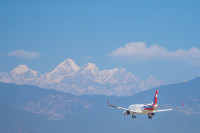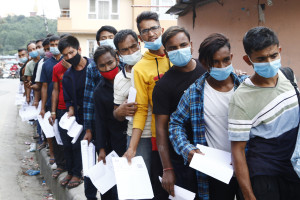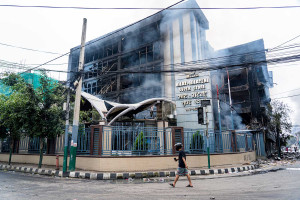Money
Nepali sky remains unsafe as reforms stall, report warns
Weak oversight, slow reforms and poor coordination make Nepal among world’s riskiest places for air travel, it says.
Sangam Prasain
Repeated air crashes have taken a heavy toll on Nepal’s aviation and tourism sectors, with the country listed among the “most dangerous countries for air travel” in international safety assessments, according to a high-level government committee report that cites remarks from global funding agencies and aviation experts.
The report, recently published on the Civil Aviation Ministry’s website, says consultations with multiple stakeholders—including donors and technical experts—found that Nepal’s airports have failed to adequately strengthen safety systems, improve passenger convenience, and enhance traveller satisfaction.
The five-member committee, led by former Supreme Court Justice Anil Kumar Sinha—now the minister for Industry, Commerce and Supplies—said its discussions with the World Bank, Asian Development Bank (ADB), and other experts, held both in person and online, highlighted the need to clearly separate service provider and regulatory roles in the aviation sector to improve governance.
The report notes that although the government has committed to institutional and legal reforms in the sector, progress has been slow. The World Bank also stressed that removing Nepal from the European Union’s “air safety list” should remain the country’s top aviation priority.
The committee has recommended establishing an independent accident investigation body, enhancing institutional autonomy and capacity, and ensuring the long-term financial sustainability of airports.
Over the past three years alone, Nepal has witnessed eight major air crashes, resulting in significant human and financial losses and raising serious doubts about the safety of the country’s aviation system.
Although various aviation laws and safety standards have been introduced over time, the rising number of domestic and international accidents suggests that the existing framework needs urgent reform.
Nepal’s first recorded air crash took place in 1955. As of July 2024, the country has seen 105 air crashes claiming 914 lives. Between December 1989 and January 2024, there were 52 crashes, placing Nepal 33rd among 207 countries in terms of the number of air crashes.
According to the report, Nepal ranks 12th globally in terms of total fatalities.
Helicopter services began in the 1960s when Royal Nepal Airlines Corporation introduced American Bell helicopters, later expanding its fleet with Russian-made aircraft. After the government adopted an open-sky policy, private operators also entered the sector.
Over the past 63 years of helicopter operations, Nepal has recorded 40 crashes that killed 92 people—reflecting persistent safety gaps and the need for major structural and regulatory reforms.
The World Bank also urged authorities to effectively implement the airport network plan, improve airport capacity, and bridge service quality gaps. It called for an integrated approach to international air connectivity alongside the development of new destinations.
In a separate discussion with the ADB—the main financier of Nepal’s airport infrastructure—the committee found that several draft aviation legislations had been prepared with the bank’s support but they were yet to be enacted.
“It was observed that there has not been the expected progress in strengthening oversight functions, which are critically important for ensuring aviation safety,” the report says. “The discussions concluded that there had been insufficient progress in ensuring aviation safety, which remains a pressing concern.”
Similarly, consultations with the International Air Transport Association (IATA) and the Board of Airline Representatives of Nepal (BARN) revealed that international airlines face procedural delays in obtaining flight permits even after receiving approval from the Civil Aviation Authority of Nepal (CAAN).
The report says poor coordination with ground-handling services has led to confusion and inefficiency. Participants described Nepal’s ground-handling system as “disorganised and uncompetitive” and called for comprehensive reforms aligned with international practices, along with strict monitoring and effective supervision.
A lack of timely and updated weather and aviation information has also hampered smooth operations. According to IATA guidelines, seasonal flight schedules must be approved and released at least 60 days in advance. However, the civil aviation authority lacks a dedicated department to manage slot allocations efficiently. Frequent changes to operational or technical notices without prior consultation have affected coordination and predictability, the report adds.
International airlines also informed the committee that CAAN had compelled them to operate flights to Bhairahawa and Pokhara airports before essential facilities and safety systems were fully operational. “They expressed that such conditions had damaged confidence in Nepal’s aviation safety environment,” the report says.
To address these issues, the committee recommended conducting detailed studies on the operational experiences of the Bhairahawa and Pokhara airports, assessing safety, infrastructure, and commercial feasibility; recruiting qualified professionals for airport management; and improving services to attract airlines rather than compelling them through regulatory pressure.
The report further notes that although the government has imposed an airport development fee on international passengers, there has been no comprehensive impact assessment. The resulting increase in airfares has discouraged travel and hurt tourism and foreign employment, as many passengers now travel to India and book cheaper flights, causing revenue losses to Nepal’s aviation economy.
The committee also received suggestions to review the multiple fee structures imposed by CAAN. It found that coordination between airlines, CAAN, Immigration, and Customs at Tribhuvan International Airport remains weak, as each agency prioritises its own jurisdiction, creating operational bottlenecks.
“It is necessary to identify and address such procedural and management gaps through a coordinated approach,” the report says. The committee has called for an effective operational schedule for busy airports, functional emergency response systems, and improved passenger safety facilities.
Airlines should be given at least three months’ notice before any regulatory changes affecting their operations, the committee recommends. Airport security systems must be modernised, international safety standards enforced, and independent experts with global experience engaged. It also emphasised simplifying passenger procedures, improving rest areas and luggage handling, and upgrading other essential facilities to enhance travel efficiency and satisfaction.
The Cabinet meeting of the previous government, held on October 18, 2024, formed a high-level committee on civil aviation reform to provide actionable recommendations.
The committee began its work on November 17, 2024.




 11.12°C Kathmandu
11.12°C Kathmandu













%20(1).jpg&w=300&height=200)

